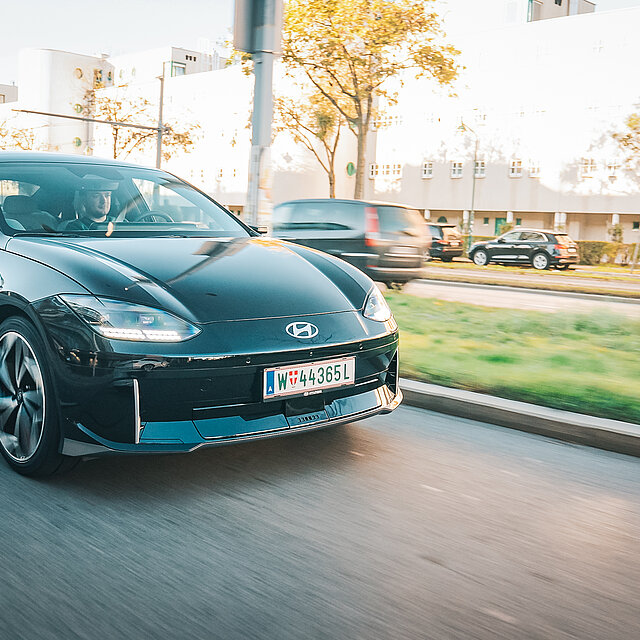How Long Do Electric Car Batteries Last?
Last updated:
Can you imagine that 1.5 million battery-electric cars were sold in 2023? To put this into perspective, that's equivalent to the entire population of Barcelona. What happens to all of them when the battery's performance decreases? And when should the car owners even have to start thinking about it?
Normally, the manufacturer guarantees a free battery replacement within up to 10 years after the purchase. Some of the first generations of electric cars have already hit the magical warranty limit. For instance, KIA offers only a 7-year battery warranty, while its first electric vehicle was produced in 2013.
We researched the topic “How long do electric car batteries last?” and asked electric car drivers. Read on if you are curious about the lifespan and replacement of an electric car battery.
What is the Lifespan of an Electric Car Battery?
Let’s not beat around the bush and start with actual examples. Take the BMW i3, built in 2014. The ADAC automobile club found that after five years and 100,000 kilometres of use, the battery retained 86 percent of its energy capacity. Based on this, they assumed that the battery would likely degrade to 70 percent capacity within 10 years or after reaching 200,000 kilometres. Not bad at all!
When buying an electric car, you get a normal warranty for your vehicle, which is more or less a standard one. In addition, you get a warranty solely for the battery, where EV battery manufacturers can get… creative. So, reading into the details is always smart. Companies normally offer a warranty, promising that the vehicle's battery will maintain a minimum level of usable capacity over time. The warranty typically entails the battery retaining at least 70-80% of its original capacity after a certain period of use, commonly set at 8-10 years or 150,000-200,000 kilometres, whichever comes first.
Should the battery capacity drop below this threshold within the warranty period, usually around 6-7 years, the owner can make a warranty claim. If the manufacturer approves the claim, they will cover the cost of either repairing the battery by replacing individual modules or installing a new battery altogether.
Do you keep googling “how long do electric car batteries last?” We’ve got answers.
While the typical lifespan of an electric car battery falls within the range of 8 to 15 years, there are instances where batteries can last for 20 years or more.
If you don't use, take care of, or look after the high-voltage car battery correctly, the warranty won't cover any problems that come up. This is especially true for how you charge the battery. As they say, the devil is in the details.
What can jeopardise the warranty:
-
Deep discharging of the battery (hitting 0%)
-
The car has not been serviced in a timely manner according to the manufacturer's instructions
-
Improperly done repairs
How Long Do Electric Car Batteries From Different Manufacturers Last?
You made it to this part of the blog post? Congratulations! That’s where the fun begins. It appears electric car manufacturers have very different ideas about how long batteries in their vehicles last. Therefore, we looked at the most prominent examples and compared their batteries' lifespan.
Tesla battery life
If our blog posts were movies, we would leave this part for the end as a plot twist. But we prefer starting with the good part right away.
Something that makes Tesla stand out among other EV producers is the immodest estimation that its batteries are supposed to outlast the vehicle. The manufacturer assumes that the whole vehicle gets scrapped after approximately 320.000 km of usage in the U.S. and roughly 250.000 km in Europe.
What about the battery?
The company that has been selling electric vehicles for over a decade claims that after around 320,000 km, Tesla batteries degrade by just 12% (Tesla Impact Report 2022).
This sounds quite optimistic, right? So we decided to verify it and asked the CEO of go-e, Susanne Palli, who has been driving her Tesla Model 3 for 3 years. During the last 2.5 years, she noticed a range decrease of around 30 km. She has driven 122.000 km in total by now. Currently, her car’s range is 300 km in winter and 450 km in summer. The numbers suggest that battery degradation happens considerably faster than Tesla predicts. Various factors of driving behaviour, of course, influence it a lot.


Susanne Palli, CEO of go-e30 km less range
I have been driving a Tesla Model 3 for 3 years now and have travelled a total of 122,000 km. In the last 2.5 years, I have noticed a reduction in range of around 30 km. My electric car currently has a range of 300 km in winter and 450 km in summer.
Tesla battery warranty
- Tesla Model 3 Rear-Wheel Drive & Tesla Model Y Rear-Wheel Drive: 8 years / 160,000 km, with a minimum 70% retention of battery capacity over the warranty period.
- Tesla Model 3 Performance, Tesla Model Y Long Range & Tesla Model Y Performance: 8 years / 192,000 km, with a minimum 70% retention of battery capacity over the warranty period.
Source: Tesla
As you can see, the company's predictions regarding the rate at which Tesla batteries degrade and their actual commitments to cover battery replacements diverge.
Audi battery life
Audi is way less optimistic about its battery lifespan. Have a look.
| State of health up to 3 years or 60,000 km | State of health up to 5 years or 100,000 km | State of health up to 8 years or 160,000 km |
| Audi e-tron 50/55/S | 78% | 74% | 70% |
| Audi e-tron GT | 80% | - | 70% |
| Audi RS e-tron GT | 80% | - | 70% |
| Audi Q4 e-tron/SB e-tron | In clarification | In clarification | In clarification |
Source: Audi Berlin GmbH
Audi battery warranty
8 years or 160,000 km, whichever comes first.
Hyundai battery life
In contrast to Tesla's fantastic promises, Hyundai has its own way of explaining how long its car batteries last.
An electric car battery goes through different stages in its life. In the first stage, which lasts around 8-10 years, the battery is used in the car.
Hyundai battery warranty
8 years or 160,000 kilometres, whichever comes first.
Head of marketing at go-e, Ronald Kroke, has been driving his Hyundai IONIQ 5 for one and a half years now. In his case, the 160,000 km will likely occur first, as he drives around 30,000 km a year. For him, Hyundai's warranty is completely sufficient, as he has full confidence that the battery will still provide enough capacity for his needs after the 8 years or the guaranteed kilometres.
But anyway, what happens after this period is over? The battery still works, but it is not as good as before. Actually, it can still be used for many more years, depending on one’s needs. If it's not powerful enough for your Hyundai car anymore, it can be used in other ways, like storing energy or for less important tasks—we’ll look into it later in this blog post. Finally, after about 20 years, the battery can be recycled.
The company does not say anything about the battery replacement costs but mentions that the most directly correlated aspect is the battery size.
One of our go-e employees, Stephan, has been driving a Hyundai Kona with a nominal battery capacity of 67.5 kWh for two years now. He hasn’t felt any significant battery decrease so far, even though his car has 79.500 km at the moment. With a full battery, he can travel approximately 400 km in summer and around 330 km in winter.
Do you want to allow Integration of youtube videos?
Allows the playback of videos, that are hosted on youtube.com. By allowing this feature, you accept the privacy agreement of google.
How Do You Extend Your Electric Car Battery Life?
Even if the battery replacement was super cheap, it’s still better to take care of your current one to avoid all that waiting and spending money you've been saving for a rainy day. Here is what we recommend to make your EV battery last longer:
1. Don’t exaggerate with fast charging. Try using AC chargers such as our go-e Charger Gemini or Gemini flex whenever possible. While charging at high speeds with a DC charger is not a problem if you do it every once in a while, frequent charging with direct current creates excessive heat and amplifies the so-called ripple effect, which shortens the battery’s lifespan.
go-e Charger Gemini flex 2.0

The go-e Charger Gemini flex 2.0 with integrated SIM card is here and offers you a free cellular connectivity for at least 5 years. An extension is possible for EUR12 (incl. VAT) per year. The mobile wallbox offers up to 22 kW charging power for 1-phase and 3-phase charging from 1.4 kW. The smart wallbox with even more connectivity can be used both stationary in the wall bracket and mobile.
go-e Charger Gemini 2.0

The go-e Charger Gemini 2.0 with integrated SIM card is here and offers you a free mobile phone connection for at least 5 years. An extension is possible for 12 euros (incl. VAT) per year. The stationary wallbox offers up to 22 kW charging power for 1-phase and 3-phase charging from 1.4 kW. The smart wallbox with even more connectivity for your home or company car park.
go-e Charger Gemini flex

The intelligent wallbox can be used both stationary in the wall bracket and mobile. No electrician is required for the installation of the charging station. Charging power from 1.4 kW to 22 kW. 1-phase or 3-phase charging.
go-e Charger Gemini

The compact wallbox for stationary use, at home or at the workplace. Simple installation, intuitive operation and smart comfort functions. Charging power from 1.4 kW to 22 kW. 1-phase or 3-phase charging.
2. Do you really need 100% today? If you don't plan to drive your car for a while, you shouldn't charge it to 100% and then just leave it parked somewhere. In such cases, it is sufficient to charge the battery to around 60-80%. Luckily, with the go-e Charger, you can set the desired kWh limit when charging.
3. Your car is still hungry, even when you are not driving it. Do not let the battery go flat when you are not using your car for a while. Normally, it loses 1-2% of the charge per day, depending on the car. If your vehicle has been sitting around for more than 12 hours, it's best to keep the battery charged between 30% and 80%.
4. Protect your vehicle from extreme temperatures. Have you ever had your phone battery suddenly run out of power or even die when exposed to low temperatures? Well, the car battery does not like extreme heat or cold either. It won't suddenly lose a few kilometres of range after being in direct sunlight all day, but if you have the option of parking in a garage, we recommend using it.
5. Ensure your car receives timely servicing. The manufacturer promises to replace your battery for free if you take good care of it. Plus, let's be real, car repairs can be pricey. But catching battery problems early during servicing can often save you a ton of cash.
How Much Does It Cost to Replace the Battery of an Electric Car?
When it comes to numbers in e-mobility, the situation gets tricky, whether it is about how far you can go on one battery charge or how long it takes to charge your electric car. You might think it’s going to be easier with prices because it’s enough to look up what manufacturers offer. But the thing is, most EV producers prefer to keep it a mystery.
👀What about those who play their cards face up?
- According to one of Audi dealers, a battery can cost between $5,000 and $15,000 to replace.
- BMW offers the exact same numbers adding that the battery price is getting lower with time.
Out of curiosity, we asked our YouTube subscribers how much they think a new electric car battery would cost. More than 90% of respondents said that they expect the price to be between €4,000 and €14,000.
Is it worth replacing a battery with an 80% capacity for a cost exceeding EUR 10,000? Our YouTube subscribers weighed in: 40% dismissed the idea, 20% found it sensible, with 40% abstaining from an opinion. 100 people voted in total.
Can Electric Car Batteries be Recycled?
No matter how well you treat your battery, eventually, you'll need to decide whether to replace it or get a new car. Then the question arises: What happens to the old batteries? We have investigated how they can be recycled and we would like to share our findings with you.
When it comes to electric car battery recycling, the main sources of value are cobalt and nickel, followed by copper.
At the moment, there are three main EV battery recycling methods:
- Method #1: Hydrometallurgical recycling
- Method #2: Mechanical recycling
- Method #3: Pyrometallurgical recycling
Hydrometallurgical recycling
Pros:
-
Economical with minimal investment needed.
-
Operates at low temperatures and energy levels.
-
Achieves a high recovery rate.
-
Works with any battery chemistry and configuration.
-
Flexible separation and recovery processes can target specific metals.
-
Yields high-purity products, including directly recovered substrate foils.
-
Output can be converted into cathode precursors.
-
Energy-efficient compared to pyrometallurgy.
-
Produces no air emissions.
Cons:
-
Recycling optimization is required for certain battery chemicals to ensure high recovery and profit.
-
Requires a size reduction.
-
Acid breaks down the cathode structure.
-
No valuable product from LFP batteries.
-
Solvent extraction is necessary to separate cobalt and nickel.
-
High volume of process effluents that need treatment, recycling, or disposal.
Mechanical recycling
Pros:
-
Enables the recovery of 90% nickel and cobalt and 50% lithium from a battery.
-
Preserves valuable cathode structure.
-
Retrieves anode, electrolyte, and foils.
-
Suitable for LFP batteries.
-
Effective for small-scale recycling.
-
Operates at low temperatures and energy levels.
-
Minimises impacts on virgin material production.
Cons:
-
Requires mechanical pre-treatment and separations.
-
Recovered material may not perform as well as virgin material.
-
Mixing cathode materials could reduce recycled product value.
-
Needs single-cathode input.
-
May recover obsolete formulations.
-
Degradation may limit reuse.
-
Buyers need assurance of quality.
-
Not demonstrated at scale.
Pyrometallurgical recycling
Pros:
-
Works with all battery types, chemicals, and configurations.
-
No need for sorting or size reduction, even for consumer electronics batteries.
-
Recovers metals efficiently.
-
Yields higher profits from recovering cobalt, nickel, and copper.
-
Does not emit SOx during metal production.
-
Economically feasible.
Cons:
-
Gas clean-up is necessary to prevent toxic air emissions.
-
Gas treatment is energy-intensive and costly.
-
Lithium and aluminium end up in slag.
-
Further refining is needed to separate elemental metals from alloys.
-
Requires significant capital investment and high volume.
-
Not suitable for LFP batteries.
Note: According to the recent EU laws, starting in December 2025, lithium-based batteries must achieve a minimum recycling efficiency of 65%. Furthermore, commencing December 2027, specific recovery rates for critical minerals from waste batteries are mandated:
-
lithium at 50%
-
nickel at 90%
-
cobalt at 90%
-
copper at 90%
It seems like a great idea to improve the environment, right? So why don't car makers rush to offer simple battery replacements for recycling and making new ones? Well, it all boils down to money. Battery recycling is expensive. Manufacturers have to pay for collecting, processing, and recycling batteries, plus extra costs like labor and maintenance.
The good news is that governments sometimes help cover these costs. For instance, the Department of Energy (DOE) is offering $37 million in funding to cut down on expenses linked with recycling electric vehicle batteries. This funding marks the second phase of a $200 million initiative set by the Bipartisan Infrastructure Law for battery recycling and second-life applications in electric drive vehicles.
Do you want to allow Integration of youtube videos?
Allows the playback of videos, that are hosted on youtube.com. By allowing this feature, you accept the privacy agreement of google.
The second life of car batteries
Even after being used for 8 to 10 years in a car, car batteries can still work pretty well. They have about 70 to 80 percent of their original power left. Though they might not be good enough for cars anymore, they can still be used for other things. That’s what we mean by "second life." These batteries can theoretically keep going for another 10 to 12 years. So, on average, you only need to get rid of them after more than 20 years. The old car batteries can be used as home energy storage for PV panels, for instance.
We asked the head of marketing at go-e, Ronald Kroke, what he thinks about battery recycling. In his opinion, such an initiative is an additional plus in sustainability for the other areas of usage. He also added that it is vital that manufacturers point out the second life of the batteries so that more people are aware of the bright side of driving an electric car.


Ronald Kroke, Head of marketing at go-eCar battery recycling for greater sustainability
It is important that manufacturers emphasise the second life of the batteries so that more people become aware of the positive aspects of driving an electric car.
Benefits:
- Reduction of the CO2 footprint.
- The end user can get stationary energy storage at a low cost.
Drawbacks:
- After being used in the vehicle for 10 to 15 years, the battery might die quickly when reused, leading to frequent replacements.
- Higher risk of fire is to be expected.
In the developing electric car market, old batteries haven't been a big deal yet. But in about 10 to 15 years, as more electric cars hit the road, we'll start seeing recycled batteries for sale.
There are some nuances to that. Many drivers keep using their vehicle's battery even after its performance drops to 70%, and they only stop using it when it dies completely. So, for instance, initially, your car battery allowed you to travel 300 km on a single charge. Now that the battery has shrunk to 70% of its capacity, you are able to drive a maximum of 210 kilometres with it. However, as the replacement is expensive, you decide to keep it and let it degrade further.
In this case, in 10 or 15 years, the battery can't be used for other purposes and can only be recycled. So, only a few of these old batteries get a second chance to be useful. (Fraunhofer ISI, Batterien für Elektroautos: Faktencheck und Handlungsbedarf, 2020).
Summary
Is it actually worth replacing an electric car battery? Our head of marketing, Ronald Kroke, firmly assumes that he will still have 80% or perhaps even much more of the battery capacity available after the warranty of the Hyundai IONIQ 5 expires. In that case, he wouldn't consider replacing it, as the battery is the most expensive part of the car.


Ronald Kroke, Head of marketing at go-eThe car battery is expensive
You simply have to bear that in mind when buying an EV. At 60 to 70%, however, I would think about replacing the battery. But then you would first have to calculate whether it makes economic sense to replace it.
Replacing an electric vehicle’s battery can be an expensive proposition, costing somewhere between €5,000 and €15,000 or more, depending on the model. Fortunately, the batteries in today’s EVs are engineered to go the distance and are covered under battery warranty conditions, which are defined by the car manufacturer. Automakers will generally replace the EV battery pack if it falls to a specified capacity percentage while covered, which is usually 60-70 percent.
Main insights:
-
You need to take care of your car according to the manufacturer’s requirements to be eligible for the battery warranty.
-
To prolong battery life, do not charge the battery to 100% if you are not planning to drive it for a week or more.
-
It’s a good idea to opt for gentle AC charging with a smart wallbox such as the go-e Charger rather than rapid charging with DC power.
-
Occasional charging with direct current isn’t dangerous for your battery, though.
Requirements for battery recycling in Europe are getting stricter, which means the recycling process will become more effective.
We, at go-e, do not only want to make charging easy, comfy, and smart but also offer you a way to be more gentle with your car's battery.
